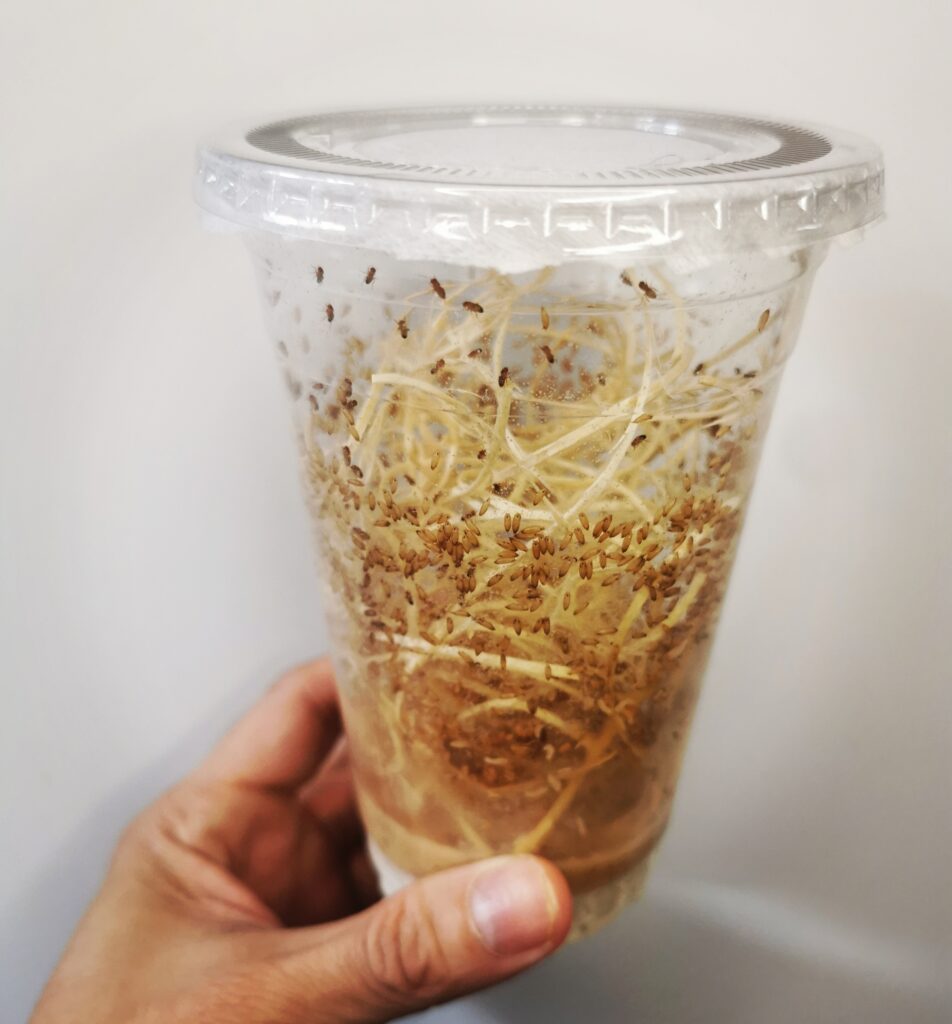Feeders 101
by Lance Lee, guided by Shaik & YT
For mantis nymphs in L1 & L2 stage, fruitflies are the best feeders.
From L2 onwards, red runners are the best choice of feeders in Singapore (in terms of nutritional value, convenience and availability)
In other countries, it might be easier to get bottleflies, which mantis love.
Here’s an in-depth guide to various feeder choices, their pros and cons.
If the feeder moves around a lot and is of acceptable size, mantids will still catch or attempt to catch. If it’s palatable, mantids will eat it and continue eating it.
Houseflies, flesh flies, blue and green bottle flies, butterflies:
These are the best feeders due to softer exoskeleton and how easily they attract the attention of mantids when they fly around.
However, it is difficult to find breeders who sell these in ultra-clean Singapore. I have seen reptile shops in Hong Kong selling them in bottle dispenser form (kept in refrigerator). Some hardcore hobbyists breed their own green bottle flies to feed their mantids but they seldom sell it as it’s quite a chore.
Red Runners (aka RR):
Overall best feeder choice. They move fast enough to attract mantis attention. Exoskeleton not as hard so its easy for mantids to consume completely, with the exception of wings and sometimes legs.
Easier for hobbyists to maintain RR colonies at home, but note that some people can be allergic to the wastes produced by RR.
Might be easier for you to buy from a trusted supplier on a weekly basis.
Beware that red runners can attack your nymphs and sub-adults especially when they are molting.
Next, let’s understand why the other feeder choices are sub-par
Crickets:
Pinhead crickets can be good choices for your L1 and L2 nymphs, but they are not good choices for your sub-adult mantids.
Two reasons:
A) Crickets can attack your mantids, especially when they are molting. After molting, mantids can take up to 48 hours for their new exoskeleton to harden, and they will be vulnerable to cricket attacks.
B) Unhealthy choice as crickets are carriers of germs and bacteria. Crickets die easily and the remaining crickets will keep their dead bodies. Especially those crickets sold by bird shops and aquariums, they are bad choices. But this could be your last resort if you run out of live food and need a temporary food supply. Note that your mantids can go hungry for 3-5 days, so it’s better to let them starve for a few days and see if you can get red runners instead.
Next, Dubias, Beetles and Isopods.
If the feeder’s chitinous exoskeleton is hard (eg. beetles, isopods), mantids will attempt to bite through the exoskeleton to get to the softer parts. If they can’t bite through or aren’t able to find an opening to the softer parts, they’ll discard the food.
Dubias:
Mantis will catch if they move fast enough to attract attention. Also hard outer shell but not as hard as beetles and isopods. Mantids will be able to bite through once they find an opening. Will be consumed completely with the exception of wings and sometimes legs.
Dubias are rich in protein and are more nutritious than red runners. However, many mantid species are picky and do not like their tastes. You could find most of your mantis rejecting dubias and go for red runners instead.
Beetles:
Although beetles are slow-moving and their movement is not as attractive to mantids, mantids will still catch if they move fast enough but they’ll usually be discarded due to hard outer shell. If mantids manage to bite through, they’ll still consume the softer parts of the beetle.
Isopods:
Mantis will still catch but will usually discard due to hard outer shell. Even if they manage to bite through, they’ll still discard because even the insides of isopods doesn’t seem palatable to most mantis species. They’ll even learn not to waste any effort in catching isopods from their first experience with them.
Next, it is tempting to feed your mantis worms. Please don’t.
Understandably, many young hobbyists have parents that object to better choices of feeders, such as red runner roaches. Mealworms and superworms are easier to buy from local fish and bird shops, and parents are more tolerable. However, these worms have very high fat contents, and are not nutritious food choices for your pet mantis.
Lastly, if you are going to mate and breed mantis, you will need to prepare fruit flies in media culture like the one below.
I make flightless fruitflies culture media like this to trade with fellow hobbyists in Singapore (for their mantis nymphs as giveaways for my instagram)
Whatsapp me at +6590778070 if you are keen to get some too
